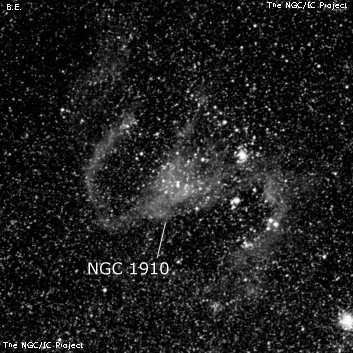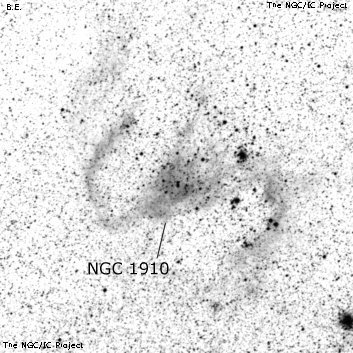NGC/IC Project Restoration Effort
(This is a very very beta version)
NGC1910


Basic Information
Location and Magnitude
Right Ascension: 5:18:33.4
Declination: -69:13:49
Constellation: DOR
Visual Magnitude: 11.2
Historic Information
Discoverer: Dunlop
Year of discovery: 1826
Discovery aperture: 9.0
Observational
Summary description: Cl, L, pRi, iR, st 11…16
Sub-type: OCL+EN
Corwin's Notes
=====
NGC 1910. JH has two slightly different positions in CGH for this cluster
(actually a large stellar association with several smaller clusters embedded).
In three sweeps, he measured a "knot" which he variously called that, a
"nucleus (which seems to be a close double star)," and a "close triple star".
That position refers to the compact cluster SL 360. JH's other observation
refers to "probably the general middle" of his large (he gives 10 arcmin, I
measure 7 x 5 arcmin) cluster, southeast of SL 360. The GC/NGC position is a
straight mean of all four observations.
Nevertheless, JH's description is very clear so we have no doubt that he was
describing the association and its brightest cluster. Brent Archinal gives
positions for both objects in "Star Clusters", and I follow his lead in the
position tables here. ESO, by the way, assigns the NGC number to the south-
eastern clump of stars in the association.
Steve's Notes
=====
NGC 1910
24" (4/5/08 - Magellan Observatory, Australia): this large, bright cluster or star cloud (stellar association LH 41) contains the variable star S Doradus (8.6-11.5), the brightest star in the LMC and one of the brightest known stars (absolute magnitude -9). At 200x, roughly 100 stars mag 11-15 were resolved in a 7' region with some extensions increasing the diameter another couple of arc minutes. S Doradus is the brightest star in the main portion of the cluster, though there are several mag 12 stars. On the northwest side (2' N of S Dor) is S-L 360, a small bright knot that is clearly non-stellar and surrounded by a thin, fainter halo (ring of faint stars on DSS).
The cluster is embedded in LMC-N119, a very large, bright emission nebula. The most prominent section of the nebula is a very bright 3' patch to the east of S-L 360 and a wing to the south of S-L 360 that responds well to a UHC filter at 200x. Nebulosity is also visible on the west side of S Doradus. This section curves N-S to S-L 360 and also south of S Doradus. To the south of NGC 1910, on a northwest to southeast stream extending a couple of degrees, are dozens of LMC clusters with NGC 1903, an impressive globular, situated 10' SW. Shapley and Nail defined NGC 1910 as the center of Constellation V, a 24' region containing a number of blue supergiants.



